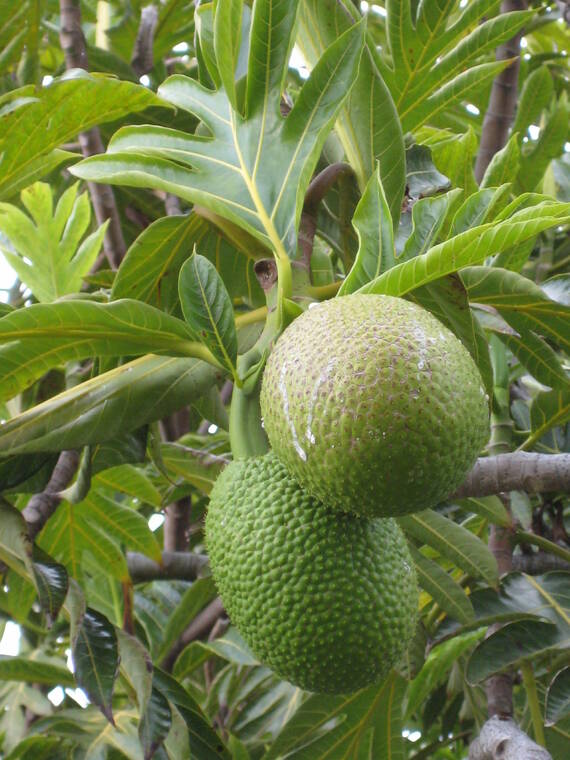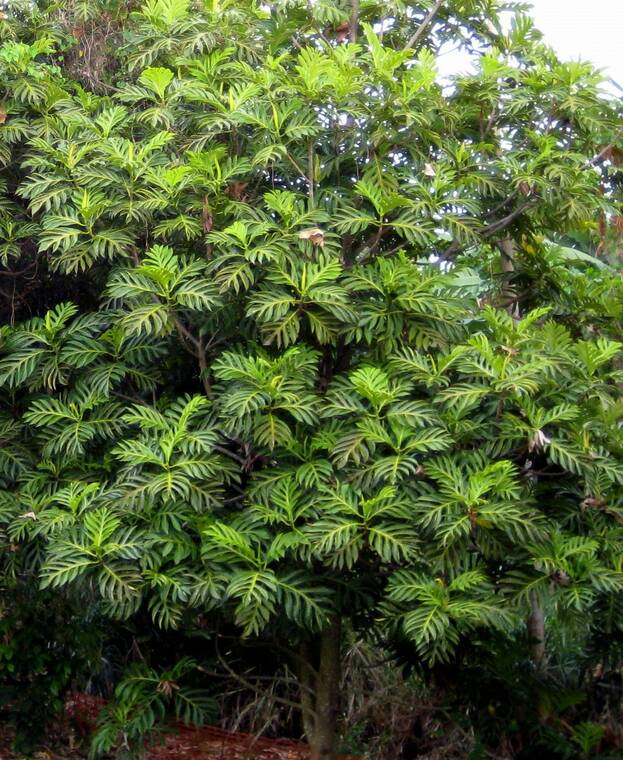A grove of ‘ulu about half a mile wide once stretched across Kona from above the modern town of Kailua-Kona to as far south as Honaunau, at an elevation of about 800 to 1,200 feet elevation. Breadfruit was an important food source for native Hawaiians and the trees also yielded products for cultural and medicinal uses. Today, many people plant ‘ulu trees to enjoy their breadfruit as well as to provide shade on their property. Though breadfruit trees are usually large, some varieties are a bit smaller and all can be pruned to control size. Consider gracing your landscape with one of more of these lovely Hawaiian heritage trees.
Majestic ‘ulu trees have grown throughout the Pacific Islands for more than 3,000 years. They arrived in Hawaii on the canoes of the early Polynesian settlers, and ‘ulu was an important food source for native Hawaiians. They sometimes used the wood for construction and often collected the latex sap as an adhesive or to seal wounds. The dried male inflorescence or catkin could be burned to repel insects.
Hawaiians learned quilting from European settlers, and the large leathery leaves of the breadfruit tree inspired the distinctive patterns of Hawaiian quilts.The leaves can reach up to 3 feet long and are still used as a tropical design motif.
‘Ulu is the Hawaiian name for the breadfruit tree. The tree is a member of the Moraceae or fig family and has a scientific name that likely relates to the fragrance and texture of the ripe fruit that resembles bread dough. The name Artocarpus altilis comes from a combination of the Greek words artos for bread and karpos for fruit. Atilis is Greek for fat.
Of the many breadfruit varieties that exist, most of those grown in Kona are the Hawaiian ‘ulu maoli or the Samoan or Tongan ma’afala. The Hawaiian Ma’opo and the Tahitian Otea are also available. All have similar fruit.
Grown in favorable conditions, Hawaiian ‘ulu trees can grow to 50 feet or more. The Ma’afala variety is somewhat smaller and more compact. Numerous breadfruit varieties now grow in more than 90 tropical countries around the globe and the tree holds great promise for alleviating hunger in the tropics.
Breadfruit trees grow rapidly and usually produce fruit within three to five years. Both male and female flowers develop at the ends of branches on a single breadfruit tree. A long thin male catkin holds hundreds of tiny, yellow flowers with pollen that fades to dark brown. Pollination is not required, but female flowers appear and fuse together as they mature forming the skin and developing the fleshy breadfruit.
The trees can be productive for many years, providing lots of light green, oval fruit that can weigh between two and five pounds each. Though fruit is generally produced year-round, it can take four or five months to reach full maturity. At this point is it good for use as a vegetable. After about five months it will ripen fully and may fall from the tree.
Here in Kona fruiting peaks during the late spring and summer months. Mature fruit, picked when green, will not be fully ripe until the latex sap turns brown. Ripe fruit will often have yellowish skin and fall from the tree. Inside it will have cream-colored flesh that is delicious raw or cooked.
The fruit can be baked, steamed, boiled, broiled or fried and served as a starchy vegetable or incorporated into bread or a dessert. Recipes for cooking ‘ulu abound online. One local source can be found at the ‘ulu coop website: https://eatbreadfruit.com/pages/recipes.
‘Ulu fruit is usually seedless and the plant is best propagated vegetatively. Root cuttings, air layering and grafting are possible techniques, though the easiest propagation is done using root shoots. Breadfruit roots typically grow on or slightly below the soil surface and can produce a shoot, especially when wounded or injured. When the shoot has developed some roots and is about 18” tall, it can be detached from the mother plant. Cut the mother root on both sides of the shoot leaving a few inches on each side and avoiding damage to the shoot’s roots.
Once the plant is growing well on its own you can transplant it to a new location. Keep the new seedling adequately watered and protected from harsh sun until it is well established. Breadfruit trees can grow in full sun or partial shade and they prefer a soil rich in organic matter that drains well. Though they can tolerate short periods of drought, they can develop root rot in wet, saturated soil.
Breadfruit is relatively disease and pest-free when well-maintained in healthy soil. Insects like white fly, scale or mealy bugs have been known to attack plants but are not life threatening and can be easily controlled if caught early. Fruit rot is best controlled by picking mature fruit before it ripens and removing affected fruits from the tree or the ground.
To keep breadfruit trees low and compact, may require light seasonal pruning. For information on pruning as well as harvesting and other maintenance recommendations check out the publication by Craig Elevitch, Diane Ragone and Ian Cole at https://www.researchgate.net/publication/261760864_Breadfruit_Production_Guide_Recommended_practices_for_growing_harvesting_and_handling.
Since breadfruit trees drop many large leaves their need for additional fertilization is minimal. The mulch that the leaves provide not only keeps the soil beneath them fertile, healthy and moist but the leafy padding can soften the fall for ripe fruit.
Planting breadfruit will not only add beauty to your garden but an interesting Polynesian vegetable to your table. In West Hawaii, many nurseries will order breadfruit plants for you. The ‘Ulu Coop also sells trees.
Peter Van Dyke of Amy Greenwell Garden reviewed this column for botanical accuracy.
Diana Duff is a plant adviser, educator and consultant living part time in Kailua-Kona.
Gardening Events
Every Saturday: “Work Day at Amy Greenwell Garden” from 9 a.m. to 12:30 p.m. Meet at the Garden Visitor Center across from the Manago Hotel in Captain Cook. Come with a mask and be prepared to practice social distancing. Volunteers can help with garden maintenance and are invited to bring a brown baglunch. Water and snacks provided. Call Peter at (808) 323-3318 for more information.
Anytime: “Macadamia Orchard Management Workshop Videos” recordings of Hawaii Macadamia Nut Association’s 2021 workshops. Go to https://youtu.be/IF53xjCH9Fw and/or https://www.youtube.com/playlist?list=PL1o2jsp9Gz4k87LJdmkIsO7xfsbLLEO5M
Farmer Direct Markets (check websites for the latest hours and online markets)
Wednesday: “Ho‘oulu Farmers Market” at Sheraton Kona Resort and Spa at Keauhou Bay
Saturday: “Keauhou Farmers Market” 8 a.m. to noon at Keauhou Shopping Center. Information on their online market: keauhoufarmersmarket.com/onlinemarket
“Kamuela Farmer’s Market” 7:30 a.m. to noon at Pukalani Stables
“Waimea Town Market” 7:30 a.m. to noon at the Parker School in Waimea
“Waimea Homestead Farmers Market” from 7:30 a.m. to noon at the Waimea middle and elementary school playground
Sunday: “Pure Kona Green Market” 9 a.m. to 2 p.m. at Amy Greenwell Garden in Captain Cook
“Hamakua Harvest” 9 a.m. to 2 p.m. at Highway 19 and Mamane Street in Honoka’a
Plant Advice Lines
Anytime: konamg@ctahr.hawaii.edu; Tuesdays and Thursdays from 9 a.m. to noon at UH-CES in Kainaliu at (808) 322-4893.






